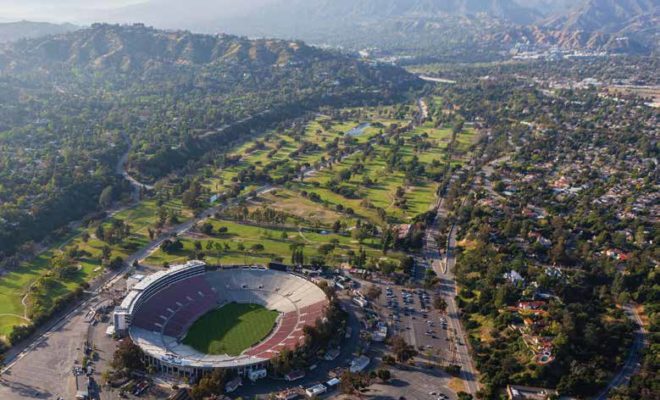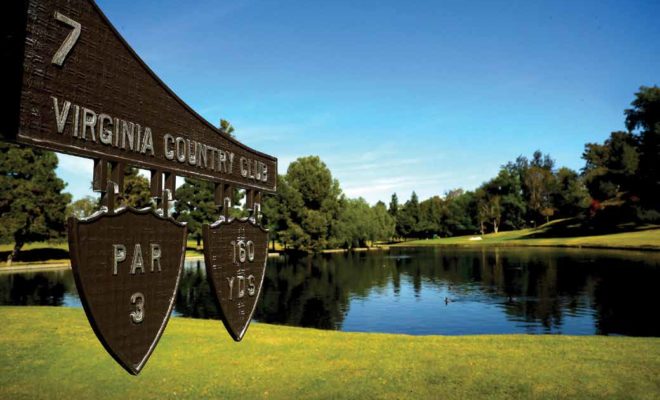Checkpoint Birdie: SoCal’s Military Golf Courses
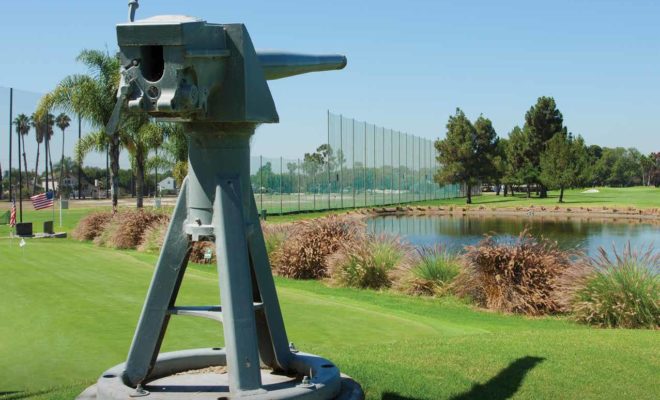
Drawing near the base entrance, the uniforms become visible. Tension grows in your stomach. You realize the sentinels ahead aren’t fooling around. Your heart beats faster as the guard checks your pass and eyeballs your vehicle.
Once you’re in, you’re on their turf, answering to their rules. You’re on your best behavior: you make full stops; your shirt is tucked in; your hat is on straight. Actually, appropriately vetted civilians needn’t fear … it’s not Checkpoint Charlie. In fact, the uniformed men and women at the gates are friendlies, the first line of security for U.S. military facilities. If you’re arriving to play golf at an on-base military golf course in Southern California, and your paperwork is in order, you’ll not only get through, you’ll be welcome.
There are 10 military golf facilities currently operating in Southern California, some more widely known, others deep, dark regional secrets. Civilians must apply for access, and submit to vetting before being granted a pass to play within base gates. However, the application process has been streamlined, and thousands of civilians have happily jumped through additional security hoops to utilize one of the military’s greatest recreational legacies.
Many of the facilities only began allowing civilian play this century. But the military has used golf courses as primary on-base recreational outlets for all its branches since World War II. Noted Southern California golf architect, and SCGA Hall of Famer, William F. Bell, who consulted with the U.S. Army Corps of Engineers to design Camp Pendleton’s Marine Memorial GC, had a hand in devel-oping four of the courses.
Like any civilian business, military courses attempt to turn a profit by generating a range of revenue streams, then reinvesting in the product for the good of the customers, most of whom are active duty and retired military. The courses are self-sustaining despite some of the lowest green fees in the game. Military (and retired military) members have playing priority, can make tee times in advance, pay less, and in some cases may play for free (or $1) during specific weekly windows.
After the vetting process is completed, most on-base courses offer daily, weekly, monthly and even annual passes for civilians. At the three off-base facilities — Barstow’s Marine Memorial, the Navy Course in Cypress and San Diego’s Admiral Baker — civilians and military simply drive into the parking lot as they would at any non-military facility.

China Lake Golf Course: Naval Air Weapons Station, China Lake
When the men and women of the Department of Defense take time away from making things that go boom, they can recreate by making birdies at China Lake GC. Designed by William F. “Billy” Bell and built in 1957, the course plays to a par of 72 and can stretch to 6,912 yards. As the NAWS is primarily a research and development facility, a majority of base employees are with the Department of Defense, rather than active military. Golf operations assistant David Sappington, who has worked at the course for 32 years, said 80 percent of the 4,500 annual rounds at China Lake are turned in by Department of Defense affiliates. For civilians, day, monthly and yearly passes are available. While the high desert comes into play for the serious slicer/hooker, a great majority of the fairways have trees lining at least one side, and there are three large ponds that come into play on four holes. “Overall, it’s fun. I wouldn’t say it’s super-hard, but I wouldn’t say it’s easy, either,” Sappington said. “I think it’s a fair, good test. If I play a good round out here, I feel like I’ve earned it.”

Muroc Lake Golf Course: Edwards Air Force Base, Edwards
Northeast of Lancaster, isolated in desert surroundings big enough to land the space shuttle, sits Edwards Air Force Base. It’s the home of the USAF Test Pilot School, the 412th Test Wing Electronic Warfare Group (EWG) Avionics Test and Integration Complex, and Muroc Lake GC, another Billy Bell design opened in 1967. The unrelenting desert provides a starkly beautiful backdrop. However, despite its desert location and the existence of a 15,024-foot runway nearby, there’s a surprising amount of elevation change, trees and turf coverage. The par-72 course can play as long as 6,915 yards, and does a brisk business in spite of — or because of — its location. Manager Donovan Huisjen, a former Air Force sergeant who’s been the manager since 2015, said the course hosts 18,000 rounds a year, and only about a third are civilian rounds. “It’s kind of a parkland-style course, but it’s shrunk down quite a bit over the years because of irrigation,” said Huisjen, who began working at the course as its superintendent in 2002. The clubhouse features men’s and women’s locker rooms and the newly renovated Sandbagger Grill. The course offers a “Golfers Special” for $35 ($30 during the week) providing unlimited golf, a range token, a hamburger, fries and a drink.
Marine Memorial Golf Course: Logistics Base, Barstow
Marine Memorial GC has several distinctions from other military facilities. First off, it’s a nine-hole course. Second, it’s not “on-base,” meaning there’s no need to secure a civilian pass or venture onto base grounds; you simply drive up to the clubhouse, which is just outside the base’s front gate. Military players have to cough up $17 for an 18-hole round in the summer, $13 in winter. Course manager Michael Berg, who retired from the base in 2010 as a sergeant major, said the par-36, 3,223-yard course was built alongside the facility in the early 1940s. There are two sets of tees should players desire an 18-hole round. “It’s definitely a desert course in the Mojave, but every one of the fairways is lined with pretty large trees and is fairly narrow,” said Berg, who took the manager’s job in July. “So you’ve got to hit straight or you’re playing from behind a tree. For a nine-hole course, it’s pretty challenging.”
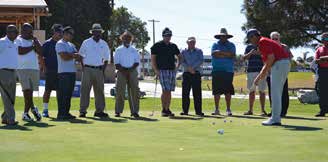
Seabee Golf Course: Naval Base Ventura County, Port Hueneme
Originally designed as a nine-hole course in 1955, the Seabee GC is now an 18-hole, par 71, playing to 6,270 yards. Head pro Efren Bautista said the course hosts about 30,000 rounds a year, evenly split between active military, Department of Defense and civilians. The original nine serves as the front nine, and has more tree-lined fairways than the newer holes that compose the back nine. “We’d love to have more civilian play. We’re a standard golf facility, and the course is a lot of fun. We’re just behind a gate,” Bautista said. “We probably have some of the lowest green fees in the county. It’s $50 for civilians to play with a cart during peak times, and promotional rates can knock that down to $37. During super-twilight times, it’s only $21 to ride.”

MCAS Miramar Memorial Golf Course: Marine Corps Air Station Miramar, San Diego
West of Torrey Pines, on a wedge of land just north of the Marine Corps Air Station Miramar airstrip, sits the Miramar Memorial GC, an 18-hole course designed by Jack Daray Jr. and opened in 1966. MCAS Miramar was a Naval Air Station before the Marines took over, and a volunteer force of Navy volunteers executed the construction of the course. Miramar Memorial is a par 72 that plays 6,800 yards from the championship tees and features the longest par 5 in San Diego, the 641-yard ninth. The course opened its doors to civilians for the first time in 2009, and Director of Golf/General Manager Mark Hayden said the word is still getting out. While conditions at some military facilities can fluctuate with water costs and availability, Miramar Memorial typically boasts superior conditions, claiming their greens are some of the best in San Diego.
Marine Memorial Golf Course: Marine Corps Base Camp Pendleton, Camp Pendleton North
Currently celebrating its 70th year of operation, the Marine Memorial GC was Billy Bell’s first effort for the U.S. Military in Southern California. It’s a traditional parkland-style, par-72 layout at the foot of Windmill Canyon, tucked into the southern half of the massive 125,000-acre Camp Pendleton between San Clemente and Oceanside off Interstate 5. The course plays 6,865 yards from the back tees, and along with its classic feel, the atmosphere at Marine Memorial is pure military; the ground shakes when Marines work with live ammunition, and the skies are often filled with the latest rotorcraft technology. The base has recently reinvested in the facility by renovating the clubhouse, and opening the new Windmill Canyon restaurant and sports bar. The golf course project was more of a restoration than a renovation. After recovering Bell’s original plans, all bunkers and greens were restored to their original locations and sizes. Abbie Bachert, tournament coordinator for the facility, said there’s no water on the course, with the exception of a drainage ditch on the back nine. “You’re not going to lose a ball,” she said.
Desert Winds Golf Course: Marine Corps Air Ground Combat Center, Twentynine Palms
Even though Desert Winds GC is the only golf course in a 60-mile radius, Head Professional Gene Shouler said his biggest problem is “getting Marines out to the golf course.” The Marine Corps Air Ground Combat Center is not only just outside the town of Twentynine Palms, Shouler said there are a number of other on-base recreational options, including ball fields, a gym, a track, even a bowling alley. Even then, he estimates the course does 13,000 rounds a year, 60 percent of which are carded by military personnel. Designed by Jeffrey Young and opened in 1966, the course is a par 72 that plays 6,930 yards from the back tees. The facility is situated well behind the base gates, overwhelmed by open desert, with a large hill that gives the course its personality, particularly the back nine. “It’s a desert course for sure,” Shouler said. “But there are a lot of trees on our course; mostly pines, eucalyptus and palm. The front nine is fairly easy, and the back nine is a little bit longer, a little more difficult.” Civilians have the option to purchase a punch card that will allow base access.

Navy Golf Course Destroyer/ Cruiser: Naval Weapons Station, Cypress
This is the house that built Tiger Woods. Billy Bell, who designed the original incarnation of the course in 1966, wouldn’t recognize it today after Ted Robinson and Casey O’Callaghan took turns renovating the course, using some of Bell’s holes for the facility’s executive layout, the Cruiser Course.
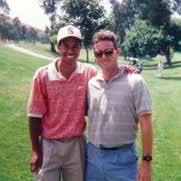
Woods, however, knows the Navy GC backward and forward, as it was the course where he spent a chunk of his childhood training to become the superstar he is today. A par 72 that plays to as much as 6,780 yards, the Destroyer is adjacent to what is now the Joint Forces Training Base Los Alamitos, formerly a Naval air station, then an Army air base. When the base was reapportioned to the Army Reserve and National Guard, the Navy kept the golf course. The facility was originally assigned to the Long Beach Naval Station, but when LBNS closed as part of the Base Closure and Realignment Act of 1990, NAS Seal Beach assumed control of the course. Since it’s not behind the gates of a military facility, there are no security requirements.
Sea ‘N Air Golf Course: Naval Air Station North Island, San Diego
Sea ’N Air GC is unique in many ways, even for a military facility. It’s one of only two golf courses on the Coronado Peninsula proper, it features a handful of links-style holes that play along the Pacif-ic Ocean, and it’s a par 71 with five par-3 holes. Also, because NAS North Island is home to two U.S. aircraft carriers, 19 air squadrons and a significant arsenal to stock the Pacific Fleet, civilians must be sponsored by qualified military person-nel in order to access the course; there’s no unescorted civilian play. Despite that, Sea ’N Air still does 55,000 rounds a year, 90 percent of which are carded by active/retired military or DoD employ-ees. According to course staff, Sea ’N Air was originally a nine-hole layout when it opened sometime in the 1940s, but was rebuilt and expanded to 18 holes in 1984. Because of its location, the course doesn’t struggle with water issues like some oth-er military facilities, and superintendent Jim Svoboda has taken advantage of the growing conditions to keep things green from wall to wall. The base’s main runway is very near Nos. 16 and 17, so golfers are regularly treated to air shows featuring F-18 fighters and pilots qualifying for aircraft carrier landings.
Admiral Baker Golf Course: Naval Base, San Diego
Admiral Baker GC offers two courses, the North and South, both of which have their own personalities. The North Course features tees, bunkers and greens that were renovated in 2012, plays to a par of 72, and stretches to 6,820 from the back tees. The South Course is shorter at 6,129 yards from the back tees (par 72), and tends to lure more entry-level players than the North. Swirling winds and large greens provide the challenge on the North Course, while the South Course offers more of a shorter, “country club” play, with tree-lined fairways and push-up greens. The facility’s staff has verified the two courses do a whopping 120,000 rounds a year (65,000 North, 55,000 South), and 75 percent of those rounds are active military, DoD employees and retired military. Civilians were granted access to the facility in 2012, and their slice of the rounds-per-year pie continues to grow. The facility itself is some 10 miles north of the Naval Base San Diego, just east of Interstate 15, so civilian players can drive right into the parking lot.

